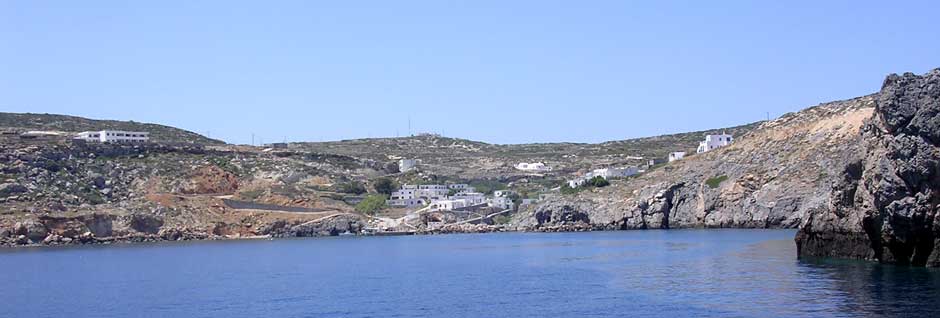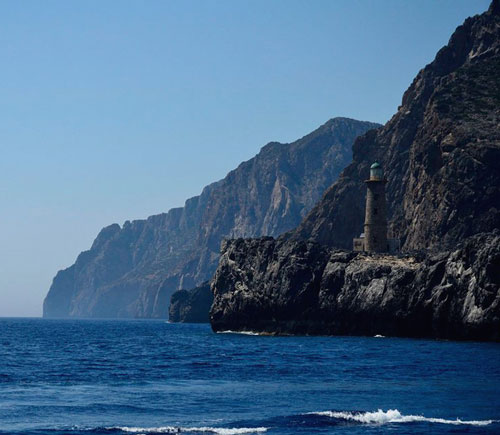The Antikythira relocation program published on the internet does not exist!
Please don’t send me any more inquiries!
The Community of Antikythera demographically is one of the smallest in the Greek territory as the permanent residents are only 45 and the active municipal roll isn’t more than 200 individuals. The Community constitutes the independent primary Organism of Local Self-government located in the settlement “Potamos” of Antikythera island. It is administrated by a nine-strong elected Community Council.
Antikythera belongs administratively to the Prefecture of Piraeus. The residents of the island are 45, but on summertime there are more than 500. The extent of the island is roughly 22 square kilometres. On the island there are enough small settlements while most residents live in the village of Potamos, which is also the port of island. During the last years, the Community of Antikythera has inverted the image of island with many infrastructure works that has materialised. On the island two cafe – groceries function, there is a medical statios and a police station, while lastly a new ultramodern heliport has functioned. In Potamos you can find a card phone, the island is connected sufficiently by all the networks of mobile telephony. The island has a good road network.
The island is connected with continuous sailings to Piraeus (9.5 hours), Gythion of Lakonia (5 hours), Kythera (2 hours), Neapoli of Lakonia (4.5 hours) and Kastelli Kissamos of Crete (2 hours).
The access to Antikythera is easy. For the boat routes you can be informed from the port authorities and travel agencies of Kythera and the connecting regions. The piscatorial shelter of island, in the big natural gulf of Potamos , can entertain small number of tourist and piscatorial ships.
Info: F/B Aqua Jewel – F/B Porfyrousa & Harbor Police Kythera: +30 27360 33280
THE CASTLE
The island’s, ancient walled city,the “kastro” or stronghold of ancient Aigila, lies in the north of the island above the bay of Xeropotamos , once the city’s harbour. Its walls, which date from the Hellenistic period, have survived in good condition. The city’s ruins cover about 75 acres, and it probably had about 800-1000 inhabitants. Much of the fortification has been preserved: in places, the walls stand as much as six meters tall. In the harbour of Xeropotamos there is a “neosoikos” – an inclined space or slipway where the warships from the pirate city were stored. It is carved out of the rock and in exceptionally good condition; it is one of the few in Greece that have ever been found preserved in their entirety. The ongoing excavation of the stronghold has discovered that the fortifications were first built towards the end of the fourth century BC or the beginning of the third century BC. Important repairs were made during the middle of the third century BC, after an expedition of invaders from Rhodes devastated the city.
It appears that from the beginning the castle was under the control of “Falasarna”, a well-known city of pirates in Western Crete, which used it as an observatory and isolated outpost. The island’s luck changed between 69 and 67 BC, when the Romans decided to embark on “an expedition against piracy” and after the first century BC it seems to have been abandoned. Throughout the city, archaeologists have found clear evidence of a long history of war. The majority of the archaeological objects found are residues of war, such as stone projectiles from small catapults, arrowheads, and innumerable lead sling-shots in the shape of almonds. The walls are marked by numerous and extensive repairs, and in some places the repairs were clearly hasty and improvised.
THE TEMPLE OF APOLLO
In the innermost corner of the small bay of Xeropotamos , near the ancient fortress of “Aegila”, some of the stones used to tie ships in the harbour remain. In 1880, during excavations there, a marble statue dedicated to Apollo (now on display in the Athens Archaeological Museum ) was discovered. On the base of the statue was an inscribed dedication to the god from Aristomenis, the son of Aristomides, a Thessalian from Ferres and from Nikon, the son of Kifisodoros of Athens. The same archaeologists found parts of a temple to Apollo that once stood there. Round the ancient harbour, pieces of the wall that encircled the temple and the harbour have survived, together with steps carved into the rock that led to the castle.
MEDIEVAL MONUMENTS
In Charchaliana, near today’s main settlement Potamos, a permanent settlement was built during the fourth or fifth century AD and was inhabited until the early Byzantine era (the seventh or eighth century AD). The artefacts that remain from that period on the island include numerous graves and several early wine presses – depressions for squeezing grapes, carved into the rock.
NEWER MONUMENTS
In Potamos, a complete two hundred year old watermill has been preserved. The evidence we have suggests that the ‘Watermill of Andronicos’ was built at the beginning of the 19th century and that it usually functioned during the winter. Both the watermill, built from cut sandstone, and its cistern survive. The mill’s cistern had a capacity of 60 or 70 cubic meters of water. It was filled with water brought in a ditch from the spring in Potamos. The cistern in turn supplied the water to drive the mill. The watermill had an unusual connection that let it control the flow of water from the cistern. In addition to the watermill, five nineteenth century windmills remain on Antikythera.
On the southernmost cape of Antikythera is the Lighthouse of Cape Apolytaras. It was built in 1926, and is a noteworthy monument of modern architecture. It can be reached only by ship from the sea or on foot: there are footpaths to the lighthouse from Katsaneviana and Galaniana. The lighthouse, manned by lighthouse-keepers from 1926 until 1987, was subseqently left unmanned. In 2004, the Ministry of National Defence decided to renovate the structure and the lighthouse keepers returned, giving new life to this important monument.
CHURCHES
Antikythera today has seven church es . There are three in Potamos: Saint Charalambos, Saint Nicholas at the entrance of the harbour, and the twin church of the Virgin Mary and Saint Dionisios. In Pateriana we find the church of Saints Constantine and Helen, and in Katsaneviana the Church of Saint George . Galaniana’s churches consist of one high on the mountainside dedicated to Prophet Elias, and the church of the patron saint of Antikythera, Saint Myron. In the Church of Saint Myron , the narthex or “templo” holds icons of Christ, of the Virgin Mary and of Saint Myron, all masterpieces in pure silver. The church also houses the island’s most holy and precious relic: the icon of Saint Myron, found here by Cretan visitors at a time when the island was uninhabited.
The Community of Antikythera office is located in Potamos, but the Secretary and the Stuff work in Kythera, in the Community Office in Kapsali.
Contacts:
Community of Antikythera
Antikythera, 80100
Tel.: +30 2736033004
Fax: +30 2736033471
Community Secretary Office
Kapsali, 80100 Kythera
Tel. & Fax +30 2736031930
Rooms & Apartments to Rent
Municipal Hostel: 0030 27360 33004
Sofia: 0030 27360 33040 & 0030 6977870104 & 0030 6938378671
Marika: 0030 27360 38146 & +306984143996
Kalkanakos: 0030 27360 33152 & +306944602036
Web Site: www.antikythera.info


